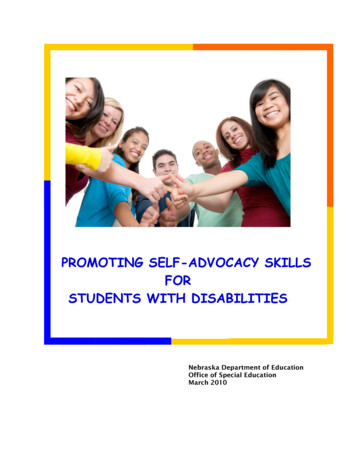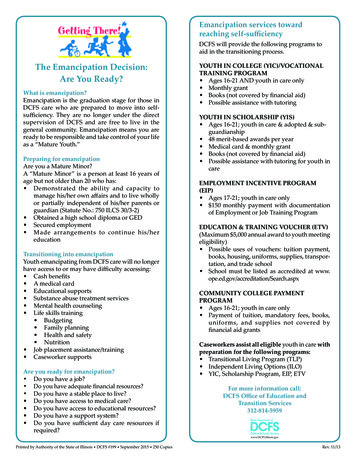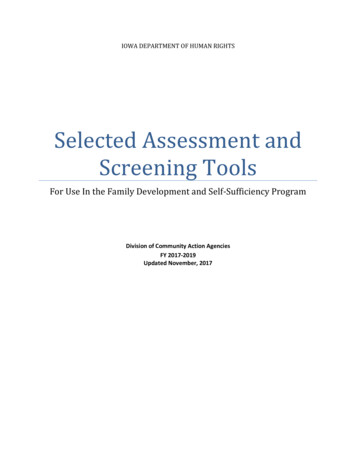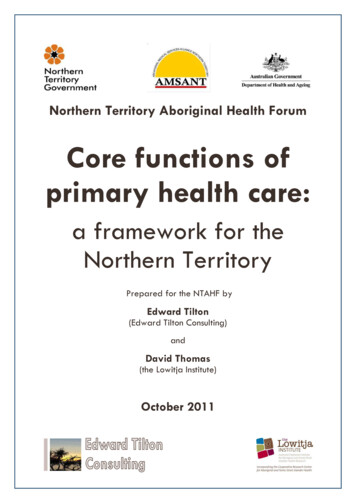
Transcription
PROMOTING SELF-ADVOCACY SKILLSFORSTUDENTS WITH DISABILITIESNebraska Department of EducationOffice of Special EducationMarch 2010
!"# #%&'()* ,-./01#2/23)*4&,,*)-#")*%50 '%*)6&%7)0&*/8&,&%& *) )Self-advocacy refers to the ability of a person to understand and explain his or her disability, strengths,and challenges. It is the ability to ask for help when it is needed. The self-advocacy movement wasstarted by and for people with disabilities because they wanted to speak for themselves rather thanhaving others speak for them. Strong self-advocacy skills are important for all, and particularly for thoseindividuals with disabilities, in order to be successful in school and in the adult world.What is the purpose of this folder?The Self-Advocacy Committee, a sub-group of the Nebraska Transition Practitioners Committee, wasformed to identify ways to assist teachers as they work with transition-age students in acquiring selfadvocacy skills. The teaching of self-advocacy skills is not intended to be a separate class or curriculum,but rather is most effective when incorporated into everyday activities and practices. This folder highlightsinformation identified by the Self-Advocacy Committee as helpful for teachers on this important topic.Additional materials and links to resources are posted on the Nebraska Department of EducationTransition website at: http://sites.esu9.org:8080/NDEtransition/.What information is provided?Information in this folder is organized around the transition components of the IEP, as defined in theIndividuals with Disabilities Education Act (IDEA) and Nebraska Rule 51. Transition planning involves thedevelopment of a coordinated set of activities to be provided in the areas of: course of study; instruction;related services; community experiences; employment/post-school adult living; daily living skills;functional vocational evaluation; and interagency linkages.A checklist was developed by the Self-Advocacy Committee to assist in identifying areas to be addressedfor individual students. The committee then identified activities and strategies to assist teachers as theybegin incorporating self-advocacy concepts into the curriculum and everyday activities. It should benoted that these activities and strategies must be individualized for each student based upon their needs,preferences and desired post-school goals. The examples will not apply to every student, will notnecessarily be completed in the course of one school year, or only be addressed in the classroom.And, last but not least, a resource listing has been compiled to provide further information on this topic.Resources include websites, print materials, and sample forms that may be useful as teachers, students,and families work together to develop ever important self-advocacy skills.
* ,-./01#2/23)27 24,&*%)Instructions: The following checklist has been developed to assist in identifying a student’sself-advocacy skills. Check the box for each item to which the student can reply “yes”. Sincethe checklist is organized around the transition components of the IEP, it can easily be used toidentify areas that need to be addressed.COURSE OF STUDY!!!!!1.2.3.4.5.I have a projected graduation date.I helped plan my schedule for this year.I know what job I want to do in the future.I know which classes will prepare me for my future job.I have a career plan that I have shared with my teacher, counselor, and/or family.INSTRUCTION!!!!!!!1.2.3.4.5.6.7.I can describe why I am in special education.I know what self-disclosure means.I understand and can explain my learning style.I can explain my strengths and challenges.I ask teachers and others for help and accommodations, when needed.I attend and participate in my IEP meetings.I know the requirements and coursework necessary for entering post-secondaryeducation.RELATED SERVICES! 1. I have received and/or may need to receive services in the following areas:" Speech/Language" Physical Therapy" Occupational Therapy" Transportation" Medical services" Orientation and mobility services" Interpreting services" Counseling" Psychological services" Job coaching! 2. I use an assistive technology device and/or programs.! 3. I know who can help me get the services I need after graduation.
COMMUNITY EXPERIENCES!!!!!!1.2.3.4.5.6.I have/plan to get a driver’s license or have a plan to meet my transportation needs.I know my legal rights and how they change at ages 18, 19 and 21.I have registered with the Selective Service (for males age 18 or over).I am a registered voter (age 18 or over).I have activities and things I like to do during my spare time.I have a friend or mentor (someone who can help me).EMPLOYMENT/POST-SCHOOL ADULT LIVING!!!!!!!!!1. I know that I can work.2. I know the job that I want.3. I know the skills I need to get a job.4. I know the barriers to getting the job I want.5. I have a plan to overcome the barriers.6. I have completed a job-seeking course.7. I know what is required for me to enter post-secondary education.8. I know what information/paperwork I need to take with me when I leave high school.9. I can manage my personal care needs on the job or in a post-secondary setting.DAILY LIVING SKILLS!!!!!!!1.2.3.4.5.6.7.I have the skills to live on my own.I know how to be safe in my own home.I can budget and manage my money.I can manage my health care needs.I can make positive choices related to recreation and leisure activities.I use appropriate social skills at work, school, and the community.I can manage my personal care needs.FUNCTIONAL VOCATIONAL EVALUATION! 1. I have opportunities to explore my interests, skills, and needs.! 2. I have used my interests, skills, and needs to drive my transition plan.! 3. I have participated in the development of my post-school goals.INTERAGENCY LINKAGES! 1. I know what services I need.! 2. I know what agencies and services are available.! 3. I know how and when to apply for these services.
/2%&1&%& *)/'0)*%"/% (& *)-#")!"# #%&'()* ,-./01#2/23)*4&,,*) )The following pages provide suggestions for activities and strategies that may be used when promotingand developing self-advocacy skills for students with disabilities. These suggestions are intended toassist educators in incorporating self-advocacy concepts into the curriculum and everyday activities.While the activities and strategies are organized around transition components of the IEP (listed below), itis recognized that there is overlap, with many of the activities and strategies being relevant to a variety ofareas.Course of StudyInstructionRelated ServicesCommunity ExperiencesEmployment/Post-School Adult LivingDaily Living SkillsFunctional Vocational EvaluationInteragency Linkages
!"# %&'"('%)#* '1.2.3.4.5.I have a projected graduation date.I helped plan my schedule for this year.I know what job I want to do in the future.I know which classes will prepare me for my future job.I have a career plan that I have shared with my teacher, counselor, and/or family.,-./0/./123%.45.16/12'1. Enroll in a career selection/career exploration course.2. Apply for a Big Brother/Big Sister or other mentoring program for help with homework.3. Attend an after school tutoring program.4. Investigate/access tutoring services through a private agency.5. Investigate/enroll in courses at the community college for dual credit.6. Enroll in an adult living course.7. Enroll in a parenting/child development course.8. Investigate process/enroll in an internship or apprenticeship program
78%) #!)7"8'1.2.3.4.5.6.7.I can describe why I am in special education.I know what self-disclosure means.I understand and can explain my learning style.I can explain my strengths and challenges.I ask teachers and others for help and accommodations, when needed.I attend and participate in my IEP meetings.I know the requirements and coursework necessary for entering post-secondary education.,-./0/./123%.45.16/12'1. Learn about students’ rights under IDEA, Section 504 of the Rehabilitation Act, and theAmericans with Disabilities Act.2. Practice self-advocacy skills by taking part in and/or leading IEP meetings.3. Enroll in self-advocacy/self-awareness course.4. Relay information to teachers about accommodations needed.5. Determine post-secondary educational plans.6. Visit college campuses and meet with Disabilities Coordinator regarding information on servicesand accommodations available.7. Consider/investigate enrollment in a tech-prep program.8. Explore admission requirements for enrollment at a Vocational/Technical or community college.9. Obtain information on continuing/adult education opportunities.10. Enroll in Community College course and/or Adult/Continuing Education course.11. Obtain/complete/submit applications for tuition assistance and/or scholarship opportunities.12. Contact Education Quest regarding their services and assistance in scholarship and grantapplications.13. Obtain/complete/submit applications to colleges of choice.14. Take a GED pretest.15. Enroll in an SAT/ACT prep course.16. Determine, with counselor’s assistance, testing to be completed and accommodations needed totake college admissions tests (such as PLAN, ASVAB, ACT, ASSET, COMPASS).
17. Once testing has been completed, meet with counselor to discuss/interpret results.18. Practice negotiation skills for job raises, car purchases, etc.19. Complete a learning styles inventory to identify learning preferences and strengths.20. Participate in time management/organizational skill building activities to assist in learning timemanagement skills.21. Take a CPR/First Aid course.22. Enroll in and take a course through the local County Extension Program.
&9,)&*'%& :7!&%'1. I have received and/or may need to receive services in the following areas:Speech/LanguagePhysical TherapyOccupational TherapyTransportationMedical servicesOrientation and mobility servicesInterpreting servicesCounselingPsychological servicesJob coaching2. I use an assistive technology device and/or programs.3. I know who can help me get the services I need after graduation.,-./0/./123%.45.16/12'1. Visit potential providers of speech/physical/occupational therapy services and identify fundingsources for these services after high school.2. Learn to use a guide dog effectively.3. Investigate sources and process to apply for a mentor.4. Practice conversations using an augmentative communication device.5. Participate in orientation and mobility training at place of employment.6. Interview/hire a job coach for assistance in learning job tasks.7. Identify possible sources of support for coping with difficult life situations, including mentalhealth/counseling services.8. Investigate resources for assessment of driving capabilities.9. Explore options for assistive technology evaluation at place of employment.10. Participate in an assistive technology evaluation to determine modification and equipment needsfor current and future living situations, including vehicle modifications.11. Investigate process to obtain new equipment (wheelchair, braces, communication device, etc.).12. Investigate process to obtain TTY/telephone system for use at college.13. Learn about services and assistive technology available at college.14. Identify sources for obtaining large print materials or Braille transcription services.
!";;#87) '& & 7&8!&%1.2.3.4.5.6.'I have/plan to get a driver’s license or have a plan to meet my transportation needs.I know my legal rights and how they change at ages 18, 19 and 21.I have registered with the Selective Service (for males age 18 or over).I am a registered voter (age 18 or over).I have activities and things I like to do during my spare time.I have a friend or mentor (someone who can help me).,-./0/./123%.45.16/12'1. Explore city/county transportation options.2. Investigate social recreational opportunities through church/temple.3. Learn about and visit places in the community to shop for food, clothes, etc.4. Investigate opportunities for social skills training/experiences in the community.5. Investigate youth volunteer programs at libraries, hospitals, nursing homes, museums, etc.6. Investigate participation in sports teams or organizations (community recreational leagues,Special Olympics teams, etc.).7. Join a community recreation center or fitness club.8. Explore opportunities through community theater, music, arts, or historical organizations.9. Investigate participation in community civic and social organizations (e.g., Lions Club, Rotary,Elks, Jaycees, Kiwanis, Arc, People First, etc.).10. Complete steps to obtain a driver’s license (study for test, take practice tests, practice driving,etc.). Investigate accommodations for testing, if needed.11. Obtain a state identification card.12. Register to vote.13. Learn to ride a skateboard, roller blade, bike, or other outdoor activity.14. Visit the mall and food court; identify stores and meals of choice.15. Register with the Selective Service.16. Observe a courtroom or jury duty process.
17. Explore “Open Microphone Night” opportunities in the community.18. Attend and participate in local government activities (e.g., school board meetings, city council,county commissioners, etc.).19. Participate in age appropriate social activities.20. Open a bank account.21. Learn about and access postal services.22. Phone friends and make arrangements for an outing.23. Develop a hobby.24. Make plans for vacation/leisure activities.25. Participate in extra-curricular activities at school.26. Register for classes with city parks and/or adaptive recreation programs.27. Join a local 4-H club.
&; 9" ;&8)3 "%) %!?""9',*#9)'97:78@'1. I know that I can work.2. I know the job that I want.3. I know the skills I need to get a job.4. I know the barriers to getting the job I want.5. I have a plan to overcome the barriers.6. I have completed a job-seeking course.7. I know what is required for me to enter post-secondary education.8. I know what information/paperwork I need to take with me when I leave high school.9. I can manage my personal care needs on the job or in a post-secondary setting.,-./0/./123%.45.16/12'1. Job shadow in a field of interest.2. Participate in a career awareness program.3. Participate in a paid or unpaid job training program.4. Explore summer employment.5. Register with Workforce Development.6. Practice completing job applications and interviewing skills.7. Obtain a paid job in an area of interest.8. Schedule an informational interview with military branch representatives.9. Memorize Social Security number.10. Attend a career fair at school or in the community.11. Develop a resumé.12. Develop a cover letter for job applications.13. Write thank you notes after job interviews.14. Meet with a Job Corps counselor.15. Determine and obtain proper clothing for job interviews.16. Volunteer or complete community service hours in an area related to employment goal.
17. Investigate adult agency services and apply for services as appropriate to needs.18. Meet with and tour developmental disabilities provider(s) in the community.19. Develop and carry personal identification.20. Obtain assistance to complete a tax return.21. Explore insurance issues/needs.22. Explore and address guardianship issues and estate planning needs.23. Learn about ways to purchase or lease a car and to maintain a vehicle.24. Learn about consumer rights and responsibilities.25. Obtain information about financial planning and investing.
*,79 '97:78@'%A799%1.2.3.4.5.6.7.'I have the skills to live on my own.I know how to be safe in my own home.I can budget and manage my money.I can manage my health care needs.I can make positive choices related to recreation and leisure activities.I use appropriate social skills at work, school, and the community.I can manage my personal care needs.,-./0/./123%.45.16/12'1. Develop a network of informal supports (i.e., friends, neighbors, etc.)2. Develop a list of numbers/people to contact in case of emergency.3. Develop emergency procedures for use at home, including putting together a disaster kit (i.e.,flashlight, radio, blanket, etc.)4. Develop and practice a safety plan for use in apartment/house. (i.e., dealing with strangers,intruders, etc.)5. Develop and practice a safety plan in case of a fire or other disaster. (i.e., evacuation)6. Select a primary care physician and dentist.7. Schedule and keep medical appointments.8. Understand procedures for filling prescriptions and taking medications.9. Meet with a doctor to discuss family planning options.10. Obtain information on managing personal health and fitness.11. Develop and practice a personal health/fitness/exercise routine.12. Develop and manage a daily time schedule.13. Use a planner to keep track of work schedule and community and school activities.14. Develop and practice a grooming routine.15. Identify different living/housing options, including exploration of supervised adult living optionsand touring apartments for rent.16. Learn about steps for renting an apartment or home.17. Investigate local insurance companies for rental/homeowner’s insurance.
18. Meet with a potential landlord.19. Visit /contact utility companies to investigate costs (i.e., gas, water, cable, telephone, etc.)20. Sign up for utilities (i.e., gas, water, electric, telephone, cable, etc.)21. Purchase items at a store with correct money.22. Assist parents in bill paying process.23. Develop personal budget plan/system.24. Open a checking/savings account.25. Learn to balance checkbook/bank statement.26. Obtain a bank ATM card.27. Develop plan/method to pay bills.28. Apply for credit cards and learn to manage personal debt.29. Obtain assistance for managing finances and legal issues.30. Meet with a family financial planner.31. Prepare initial housing budget (i.e., down payment, furniture, towels and other furnishings,utilities, cleaning supplies, etc.)32. Cost compare for purchase of household items (i.e., appliances, furniture, etc.).33. Learn to operate a washer and dryer.34. Learn about obtaining or performing simple repairs in home/apartment.35. Learn to operate a vacuum cleaner.36. Purchase clothing and learn how to care for clothes.37. Listen to the weather forecast and plan what to wear.38. Learn about expectations for dining out and practice eating in restaurants.39. Make a shopping list and purchase food to prepare a meal.40. Learn about physical and personal care of children.
(#8!)7"8,9':"!,)7"8,9'&:,9#,)7"8'1. I have opportunities to explore my interests, skills, and needs.2. I know my interests, skills, and needs are used to drive my transition plan.3. I have participated in the development of my post-school goals.,-./0/./123%.45.16/12'1. Investigate and contact community agencies that provide vocational assessments.2. Collect information regarding vocational interests and abilities.3. Complete informal transition assessment to determine preferences.4. Meet with school counselor to affirm vocational interests and align graduation plan to need.5. Complete interest inventory.6. Complete Career Cruising / NE Career Connections or other career inventory.7. Participate in nonpaid job training with a job coach.
78)& ,@&8! '978A,@&%'1. I know what services I need.2. I know what agencies and services are available.3. I know how and when to apply for these services.,-./0/./123%.45.16/12'1. Apply for housing assistance from programs such as HUD.2. Identify and visit community agencies that provide residential and employment services tosupport people with disabilities.3. Learn about Adult Protective Services.4. Contact the Commission for the Blind and Visually Impaired to learn about their services.5. Contact the Commission for the Deaf and Hard of Hearing to learn about their services.6. Meet with and interview adults with disabilities and their families who are receiving residentialsupports.7. Apply for Supplemental Security Income (SSI) from the Social Security Administration (SSA).8. Apply for Medicaid through the Nebraska Department of Health and Human Services (DHHS) forassistance with medical/health costs.9. Sign consent form for transition services through Vocational Rehabilitation (Voc Rehab); attendVoc Rehab orientation to find out about services available, eligibility, and application process.10. Learn about adult service options for people with developmental disabilities offered through theDivision of Developmental Disabilities n (DDD) and make application to determine eligibility forservices.11. Arrange for a transition period with service provider of choice prior to entering into adult serviceswith Division of Developmental Disabilities (DDD).
" *#5"2 *))NEBRASKA DEPARTMENT OF EDUCATION TRANSITION WEBSITETechnical assistance documents, sample forms, worksheets, and postings regarding transition activitiesand events are located on Nebraska’s transition website. A tab specific to Self-Advocacy resources hasbeen developed and will continue to be expanded and updated as new materials are identified anddeveloped. Visit the site at: http://sites.esu9.org:8080/NDEtransition/.A FULL LIFE AHEADA workbook and guide to adult life for students and families of students with disabilities may be orderedat: nformation about disclosure of disability may be found on a website developed by VirginiaCommonwealth University at: http://www.worksupport.com/documents/disclosure decisions1.pdfGUARDIANSHIPThe University of Nebraska – Lincoln Extension agency offers a series of free publications regardingguardianship. To view, visit the website at: p.Enter “guardianship” under Search Publications.I’M DETERMINEDThe Virginia Department of Education has gathered and developed materials to assist students, parents,and educators in supporting self-determination skills for students with disabilities. Materials may beaccessed by visiting their website at: www.imdetermined.orgLEARNING STYLES SCALEThe Learning Styles Scale is a 44 item questionnaire, developed at North Carolina State University,designed to identify individual learning style preferences. Immediate results are provided uponcompletion of the questionnaire at: l.
PEOPLE FIRSTPeople First is a self-advocacy organization whose purpose is to: speak for ourselves, learn our rightsand responsibilities, and teach others about People First. The organization may be contacted by phoneat: 308-872-6490 or by e-mail at: peoplefirstne@bigred.net.PTI NEBRASKAPTI Nebraska provides training, information, and support to parents in Nebraska who have a child with adisability ages birth through 26 with special needs. Resources are provided for parents, family members,school personnel, and interested others. Contact PTI by calling 402-346-0525 or 800-284-8520 or findadditional information at: www.pti-nebraska.org.REACHING THE AGE OF MAJORITY: YOUR LEGAL RIGHTS AND RESPONSIBILITIESThe Age of Majority booklet assists young adults in learning about their legal rights and responsibilities.Various topics are covered including: contracts, crime victims, health and human services, immigration,insurance and tax responsibilities. A complimentary copy of the booklet is available, upon request.Ordering information may be found at: http://www.nebarfnd.org/age-of-majority.THE YOUTHHOODThe Youthhood is an interactive website created by the National Center on Secondary Education andTransition (NCSET). Information for students includes opportunities to write in an online private journal,try out “brain exercises”, use a goal planner to set and achieve goals, and vote in Youthhood polls andsee how others in the world responded. For adults, the site provides a curriculum-based tool to helpyoung adults plan for life after high school. Visit the website at: http://www.youthhood.org.VOCATIONAL REHABILITATION PUBLICATIONS“Making It Work”, a quarterly publication, provides information for students with disabilities and theirfamilies regarding transition planning. The “Transition Services Planner – A Guide for Students and TheirFamilies” provides information to assist students and families in working with schools, VocationalRehabilitation, and other agencies during the transition years. To view or receive copies of either of thesepublications, visit: http://www.vocrehab.state.ne.us and click on “Publications” or contact VocationalRehabilitation toll free at 877-637-3422.
/24'#6, 0( '%*) )The following members of the Nebraska Self-Advocacy Committee are thanked for their hardwork and dedication to this project.Jan BarberESU #13Dave BrunelleNorth Platte Public SchoolsJody CisnerosESU #16Lou Cox-ForanderESU #16Barb FischerESU #9Cindy HahnGrand Island Public SchoolsJody HitesmanESU #9Seamus KellyPTI NebraskaRita SkilesESU #11Sue Van HousenESU #7Project Coordinator:Lindy Foley, Nebraska Department of EducationWriter/Editor:Lloya Fritz, Independent ContractorInformation for Activities/Strategies adapted from:O’Leary, Ed & Collison, Wendy (2007). Revised Transition Services - Helping Educators,Parents, and Other Stakeholders Understand: Postschool Outcomes, Course of Study,and Coordinated Set of Activities.Funded byNebraska Department of EducationIDEA Part B FundsGrant H027A080079
What does self-advocacy mean to me, a seventeen year old girl who has some vision loss? Selfadvocacy is my whole life. Twenty four hours a day and seven days a week, I have to advocatefor myself. Whether I am in school, at home, or in my community, I will have to self-advocate toget what I need. I don’t believe that anyone should have a disadvantage because of theirdisability.-KaseyNebraska Youth Leadership CouncilThe self advocate understands that you can’t rely on the ideas and opinions of others to guideyour own life.-AndrewNebraska Youth Leadership Council
Self-advocacy refers to the ability of a person to understand and explain his or her disability, strengths, and challenges. It is the ability to ask for help when it is needed. The self-advocacy movement was started by and for people with disabilities because they wanted to speak










